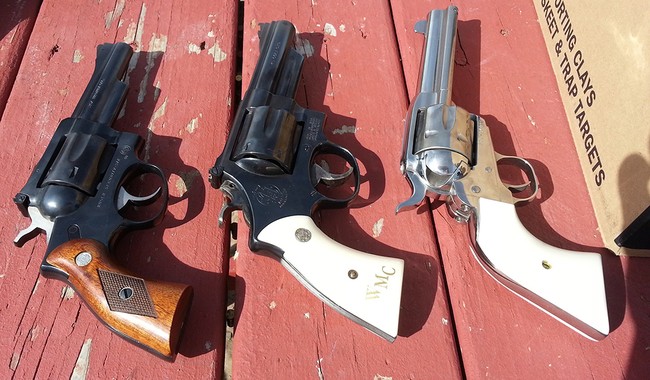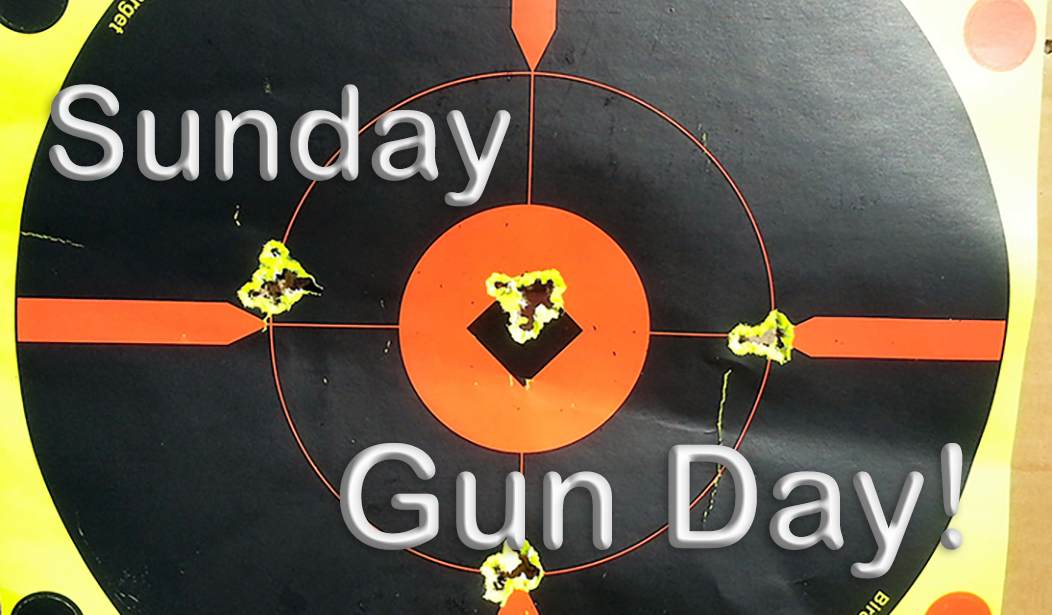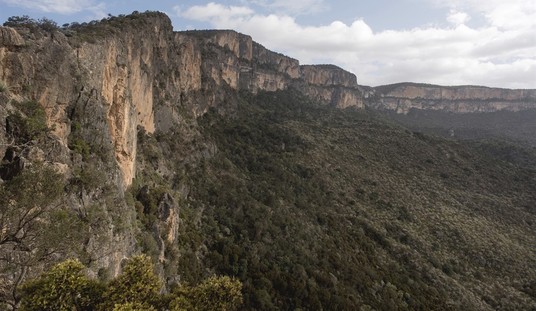Combat Magnums
There have been volumes upon volumes written about combat sidearms, and it’s rare to find two sidearm aficionados who agree on, well, much of anything, including revolver vs. auto, 9mm vs. .45, and so on. Every new sidearm introduced, every innovation in ammunition or sighting introduces a new argument, and if there's anything gun nuts love to do, it's argue about guns.
But one concept I’ve seen in multiple discussions, and one that I like myself, is the concept of a big, heavy, major-caliber, double-action revolver, which I have seen referred to as a “combat magnum.” I like the term myself and, since I’m also a fan of major-caliber revolvers, use the term regularly.
So, what is a combat magnum?
As stated, primarily a large-frame, major-caliber, double-action revolver. The piece should be manageable enough to be carried in a holster all day, with enough barrel length to give you a decent sight radius but short enough to clear leather quickly when you need to commence operations in a hurry. Caliber should be .44 or .45, although the cartridge doesn’t need to have “magnum” in the name; the .45 Colt or the .44 Special certainly qualify.
See Related: Sunday Gun Day Vol. II Ep. VII - Monster Handguns: Why?
My favorite sidearm, a 4” barreled Smith & Wesson 25-5 in .45 Colt, meets what I think of as a “combat magnum.” But that’s a reasonably modern gun – made within the last fifty years. The history of the combat magnum is interesting and goes back to the late 19th century. We start, as is so often the case when discussing revolvers, with Colt.

The Colt M1878 Revolver
Colt’s double-action revolver story actually begins with the Model 1877, a small-framed sixgun offered in three versions – the Rainmaker (.32 Long Colt), the Lightning (.38 Long Colt), and the Thunderer (.41 Long Colt.) The M1877 retained the loading gate-rod extractor setup of the Single Action Army, and its double-action was finicky and prone to breakage, but it did find some small following, with notables like Billy the Kid and Doc Holliday favoring the Thunderer, and gunslinger John Wesley Hardin reportedly carried both a Lightning and a Thunderer at one point or another.
However, some buyers were looking for more oomph in a double-action revolver, so in 1878, Colt scaled up their double-action sixgun and introduced the M1878. This was a big, heavy piece, chambered for a variety of revolver cartridges up to the .44 WCF (.44-40), the .455 Webley, the .45 Colt, and the .476 Eley. Designed by Colt factory manager William Mason and Colt engineer Charles Richards, the M1878 is very similar to the M1877, with size being the main difference. The M1878 still used the loading-gate rod ejector setup from the Single Action Army. The M1878 was manufactured until 1907, with 51,210 copies built. The US Ordnance Department bought 4,600 of them with enlarged trigger guards to provide more leverage for the heavy double-action pull; these guns are known as the “Philippine” or “Alaskan” models.
But ten years later, Colt finally put the combat magnum in its final form.
The Colt New Service/1909
The Colt New Service was a fully modern double-action sixgun, with a large, strong frame and a swing-out cylinder to speed reloading. The gun was made in a variety of versions and chambered in many calibers, including several that met the “combat magnum” criteria, including the .38WCF (.38-40), .44WCF (.44-40), the .44 Russian, .44 Special, .45 Colt, .455 Webley, .45ACP and the .38 Special/.357 Magnum. Manufactured from 1989 to 1946, about 356,000 guns were built, including two adopted by the United States military – the M1909 and the M1917.
Most gun nuts are familiar with the tales of the Philippine Insurrection, the anemic .38 Long Colt M1892 revolver, which I should note was the first Colt revolver that combined a double action with a swing-out cylinder, and how that incident led to the US military adoption of the big, tough Browning M1911 auto pistol, which remained in service for over a century and is still one of the best martial sidearms in existence. Many gun nuts also know that some Colt Single Action Army revolvers were sent to the Philippines, leading to the happy discovery that a big, heavy lead .45 slug would ruin a drug-crazed, rawhide-armored Moro tribesman’s whole day much more effectively than the .38.
But tooling up to build the 1911 was a task unto itself. So the Army had a sudden rush of brains to the head and bought a bunch of 6” barreled Colt New Service revolvers in .45 Colt, called them the Model 1909, and issued them as a stopgap – and a very effective stopgap it was, a solid, reliable revolver, quick to reload, dumping out a big, .45 caliber, 250-grain lead bullet.
The M1917 was also based on the Colt New Service – Smith & Wesson made them as well, based on their own large-frame double-action revolver, the Second Model Hand Ejector. These guns were chambered for the .45ACP and used half-moon clips to hold the rimless cartridges in place, and were, like the M1909, a wartime measure, as the more complicated M1911 was slower in production.
While Colt was thus engaged, the folks at Smith & Wesson weren’t sitting idle.
The Smith & Wesson Triple Lock and the .44 Special
In 1908, Smith & Wesson was already in the business of cranking out, like Colt, good double-action revolvers with swing-out cylinders, which had replaced Smith & Wesson’s earlier and somewhat more fragile break-top designs like the famous Schofield revolver. But in 1908, the company came out with something new, the first of the big, heavy guns on what would later be known as the N frame.
The .44 Hand Ejector First Model’s designers did more than just scale up Smith & Wesson’s smaller .32 and .38 revolvers. The new gun retained the swing-out cylinder, but added the feature that gave the gun its nickname; in addition to the lockup at the cylinder face and the end of the ejector rod, taken from the earlier Smiths, the new gun added a locking lug on the crane that locked into a recess in the frame.
This was the first of Smith & Wesson’s big-frame revolvers. This frame, which would become known as the N frame, would go on to yield such famous pieces as George Patton’s Registered Magnum, Harry Callahan’s Model 29, and my favorite Model 25-5, but the Triple Lock was the first. And the cartridge it used, the new .44 Special, was uniquely suited for the new gun, which no less than Elmer Keith considered the finest double-action revolver ever made; it was with this big, tough gun that Keith experimented with the heavy .44 Special loads that led to the development of the .44 Magnum.
See Related: Sunday Gun Day Vol. II Ep. VI - Patton's Pistols
The Triple Locks were expensive. The new gun required a lot of careful hand-fitting and tuning to make it lock up properly and maintain cylinder timing. Still, when well set up, it was utterly reliable with almost any ammunition. The Triple Lock is a joy to handle; it is smooth, with a long but glassy double-action pull and a crisp single-action trigger. Over the years, I’ve had the opportunity to handle and shoot two .44 Special Triple Locks and I’ve been watching for the opportunity to add one to my collection for some time.
Nowadays
The handgun market nowadays seems to be dominated by CCW guns and competition pieces. But as many of my fellow Alaskans (and plenty of rural dwellers across the fruited plain) will tell you, there’s still a place for a big, powerful sixgun that can hang easily in a belt holster – and there are still plenty of combat magnums made, from the Colt Anaconda to the Smith & Wesson N-frame guns and the Ruger Redhawk, just to name a few.
As long as there will be people tramping the backwoods and potentially dealing with big, toothy critters, there will be a market for the combat magnum revolvers – and, with a bit of luck and thanks to a few fortuitous Supreme Court decisions, gun manufacturers to fill the need.















